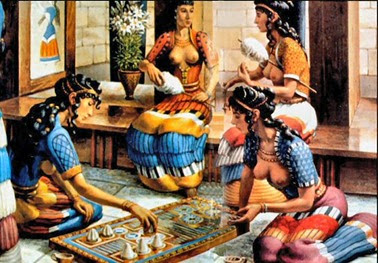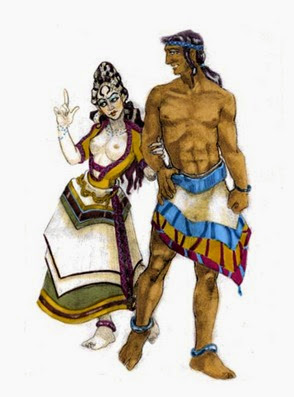As elsewhere, Cretan clothes in the ancient times were well documented in their artwork where many items worn by priestesses and priests seem to reflect the clothing of most. Wool and flax were used. Spinning and weaving were domestic activities, dyeing was the only commercial process in keeping with everywhere else in antiquity. Fabrics were embroidered. Crimson was used the most in dyeing, in four different shades.
Female Minoan dress
Early in the culture, the loincloth was used by both sexes. The women of Crete wore the garment more as an underskirt than the men, by lengthening it. They often are illustrated in statuettes with a large dagger fixed at the belt. Undoubtedly providing for personal safety was one of the characteristics of female clothing in the Neolithic era, because one also found traces of it in the peat bogs of Denmark up to the Bronze Age.
From 1750 BC, the long skirt was trimmed and began to resemble the blouse in appearance. The belt, a long or short coat and a hat supplemented the female outfit. The Cretan clothing for women was the first true bent garment in history. Ancient brooches, widespread in the Mediterranean, were used throughout the period.
Dresses also were long and low-necked such as that of the 19th century. They were so low that the bodice was open almost all the way to the waist
Male Minoan dress
Practically all men wore a loincloth. Unlike the Egyptians, the shanti varied according to its cut and normally was arranged as a short skirt or apron, ending in a point sticking out similar to a tail. The fabric passed between the legs, adjusted with a belt, and almost certainly, was decorated with metal. It was worn by all men in society.
In addition to Cretan styles, Cycladelic clothing was worn as pants across the continent. A triangular front released the top of the thighs. One could say it was clothing of an athletic population, because of this and the fact that the chest always was naked. It was sometimes covered with a cask, probably ritualistically. However, long clothing was worn for protection against bad weather and eventually a coat of wool was used by the Greeks.
Men had long hair flowing to the shoulders; however several types of headgear were usual, types of bonnets and turbans, probably of skin. Shoes were boots of skin, probably of chamois, and were used only to leave the house, where one went barefoot, just as in the sanctuaries and the palaces. People studying this matter have noticed the outdoor staircases are worn down considerably, interior ones hardly at all. It's known that later, entering a house - this habit already was in use in Crete. The boots had a slightly raised end, thus indicating an Anatolian origin, similar to those found on the frescoes of Etruria
Blogger Labels: Ancient,Minoan,Cretan,artwork,items,priestesses,priests,Wool,Fabrics,Crimson,Female,loincloth,sexes,women,Crete,garment,underskirt,statuettes,dagger,characteristics,Neolithic,peat,bogs,Denmark,Bronze,From,blouse,appearance,history,brooches,Mediterranean,Dresses,century,waist,Male,Egyptians,apron,fabric,legs,addition,Cycladelic,continent,population,fact,chest,cask,protection,Greeks,hair,headgear,bonnets,Shoes,sanctuaries,palaces,People,staircases,Anatolian,origin,frescoes,Etruria



EmoticonEmoticon